Posted by Nodus Labs | April 7, 2023
Using AI for Introspection and Psychology of Self

The most common use of AI models today is to generate text, however, these models have a huge potential to be used for introspection and the psychology of self. In this article, we will show how you can harness the power of data science to analyze your own thinking and then use AI to generate insights that can help you enhance your ideas and get a deeper understanding of yourself. This approach can be used both for professional and personal purposes: from developing your discourse on a certain topic to the psychology of self.
Normally, it can be difficult to use AI language models for introspection. We have to either train them on our own data (which can be prohibitively long, complicated, and expensive) or we can prime it with our thinking so that the responses and insights that it provides are sufficiently relevant. The question is, therefore, what’s the best way to prime it? Copying and pasting all our data to ChatGPT seems to raise both performance and privacy concerns. Besides, the answers we get will tend to be shallow and generic.
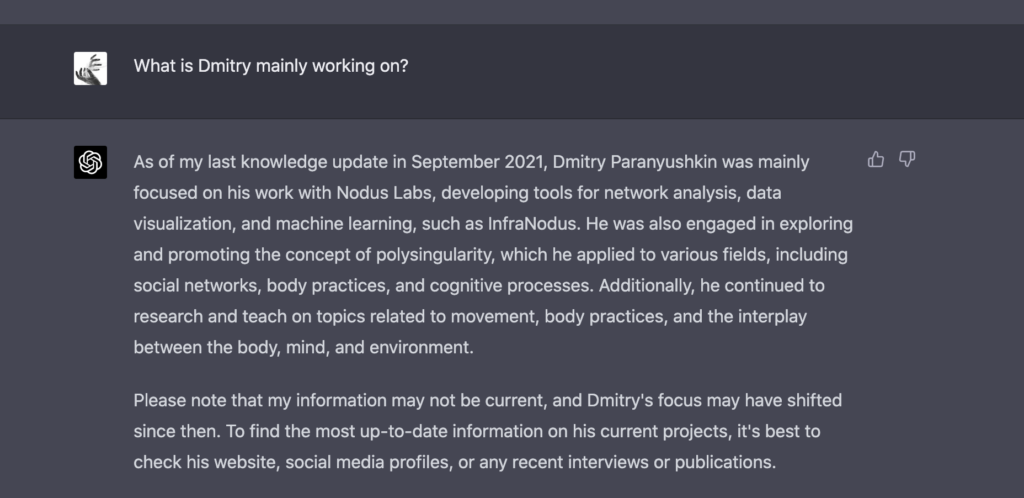
In this article, I will demonstrate how you can combine GPT AI language models with text analysis and data visualization to reflect on your own ideas and derive insights that would otherwise be unavailable.
The essence of the approach that we propose is based on analyzing the structure of thought and revealing high-level ideas, recurring themes, and gaps between distinct clusters of ideas. This will help us get both an overview of the ideas analyzed as well as reveal the gaps between them. As we obtain structural insight into our text, we can use it to prime an AI model for our content.
In this case, the model will have a basic understanding of the structure of our discourse, helping it to reveal some interesting patterns and gaps in our ideas without even having to have full access to our private thoughts.
Using the Right Dataset: Personal Notes, Diaries, Text
In order to start, we need to find a suitable dataset for analysis. We recommend finding personal notes, diaries, or any text that you wrote.
We will be analyzing this data using InfraNodus text network analysis tool, which can visualize the relations in text and reveal high-level ideas inside as well as the gaps between them. InfraNodus will then use GPT-3 AI to reveal high-level ideas (names for the topical clusters identified) as well as the gaps between them.
In this example, we will be using my personal website, where I have a “Portfolio” section of my own artistic works (see paranyushkin.com/works). The URLS of the Portfolio pages were listed as plain text and we used the built-in URL / Website analysis app in InfraNodus to visualize these pages’ content.
If you have a diary or, say, personal notes in Evernote or any other PKM, you can simply copy and paste them manually or use one of the multiple InfraNodus import plugins.
As a result, we get a data visualization of the concepts I use to describe my work as well as the main topical clusters and keywords detected in project descriptions:
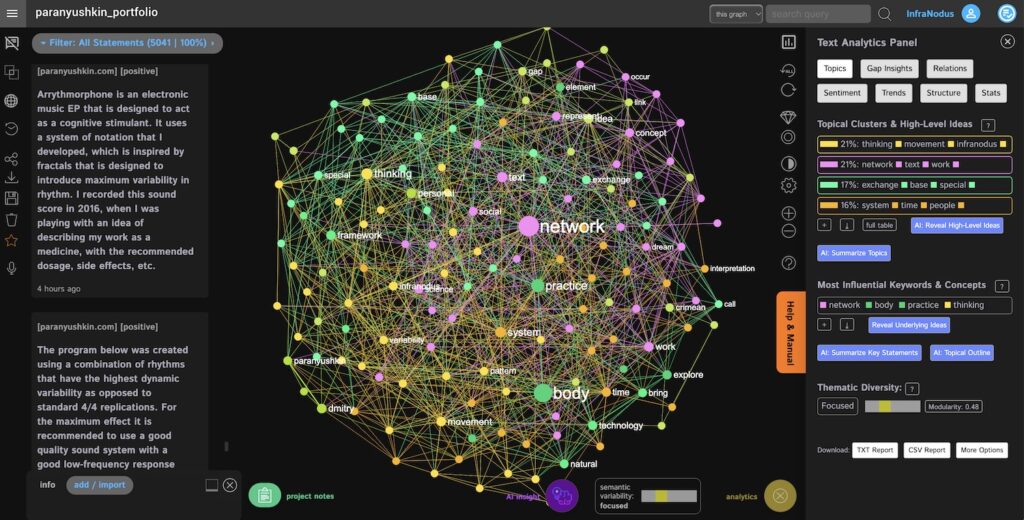
Let’s now dive into the analysis.
Personal Introspection with Text Analysis and NLP Tools
First of all, the Analytics panel on the right-hand side shows the main concepts and topics contained in these personal texts we’re analyzing.
As we can see, when I write about my work, I tend to talk a lot about
networks, body, practices, thinking
These seem to be recurrent concepts in my work and ideas.
The main topical clusters show the concepts that tend to occur in the same context — these are the most typical patterns for discourse circulation in his work:
• thinking movement infranodus
• time exchange base
• network text work
• idea gap crimean
We can interpret them ourselves or use built-in GPT-3 AI to reveal high-level ideas for each of these topics:
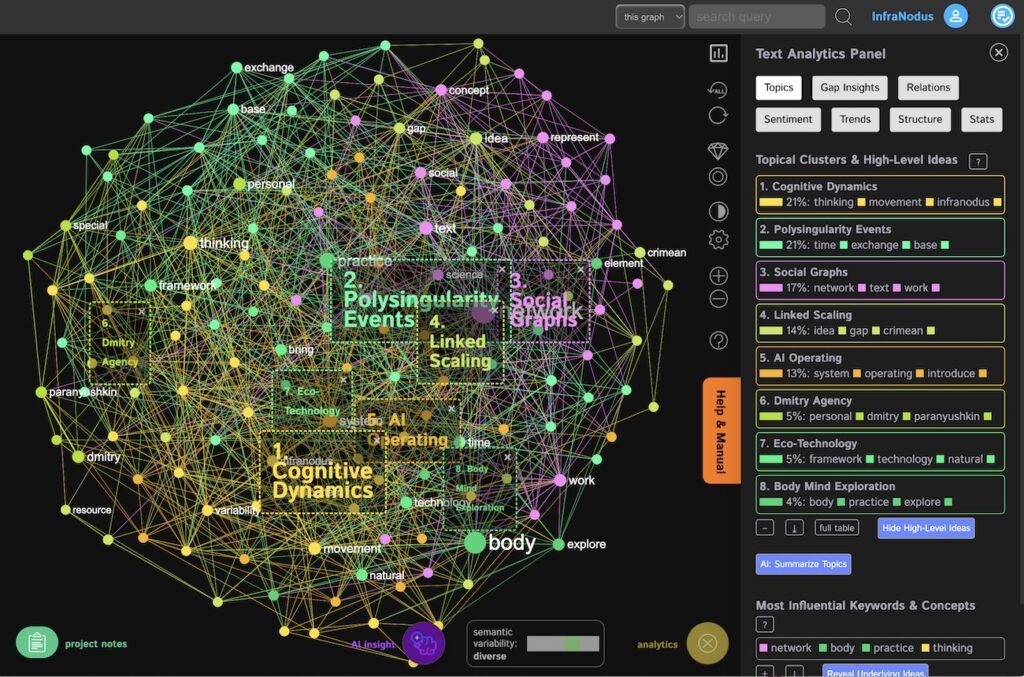
If we combine these insights with our own interpretations above, we can identify the main recurrent topics in my ideas:
• Cognitive Dynamics (how to create variability in thinking and movement)
• Temporal Polysingularity (events that promote diversity both in content and social interactions)
• Social and cognitive networks (network thinking and social engineering)
• Spatial Analogies for Thinking — scaling, waves, gaps, ideas, unification, distance, connection
• Operating Systems Metaphors
• Personal information
• Ecological and Technological Frameworks
• Mind-Body Exploration
Note, that I did not just take the AI content, but, rather, used it as inspiration for thinking about my own practice. This is an advantage of using InfraNodus: you are constantly encouraged to interpret the data you get.
Overall, my ideas are quite well represented and I can see the main topics that are contained inside. The network also has a pretty good thematic diversity level (Diverse), showing that the variety of topics is relatively high but not too high so that ideas become dispersed.
General workflow outline for this step:
- Import your text
- Reveal the main topics
- Reveal the most often used terms
- Reveal the high-level ideas
- Show the main relations
By the way, this workflow is available directly in InfraNodus’ interface (top right button), as shown in our Step-by-step Text Diagonistics Workflow support portal article, in case you want to use it with your own data.
Finding What’s Missing: the Gap between Expectations and Reality
Now that I have an overview of my main ideas, I also want to look deeper and see if there are discrepancies between my expectations and reality. Text network visualization is a great way to do that, because it shows relations between my ideas. So I can see which ideas tend to occur a lot and in which context and think if I’m missing something important.
When I look at the graph, I can see directly that there is a very strong relation between the concepts of “body” and “practice”:
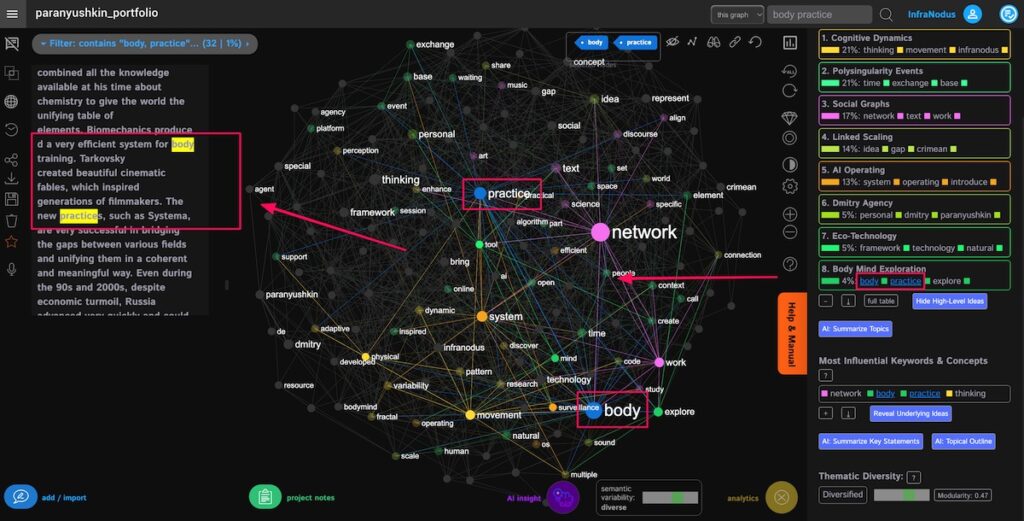
However, the topic that “body” and “practice” belong to contains only 4% of the concepts shown on the graph, which means that I don’t really elaborate on these concepts in a specific way. They have high influence, so they are often used as “connectors” between the topics. But I don’t go so much into detail about the body practices that I’m engaged with.
You can see this insight from the Analytics panel, but also from the graph itself: the node “body” is big, which means it has a high influence (calculated on the basis of the betweenness centrality measure, which shows it’s a good global discourse connector). However, it’s located at the periphery of the graph and it doesn’t have so many nodes in its “community” indicated with green.
As this concept is important to me personally, both the graph insights and the NLP analytics data show that I could develop this concept a bit further, at least in how I speak about my work, but maybe also in how I think about it. For instance, I could talk more about body sensations, movement practices, and social aspects of bodies interacting in space.
Another approach is to use the Analytics > Relations panel and to look at the top relations in your ideas. For instance, another prominent relation is the “network” and the “body”. The Analytics panel shows that these two concepts are connected to “practice”, “system”, “work”, “variability”:
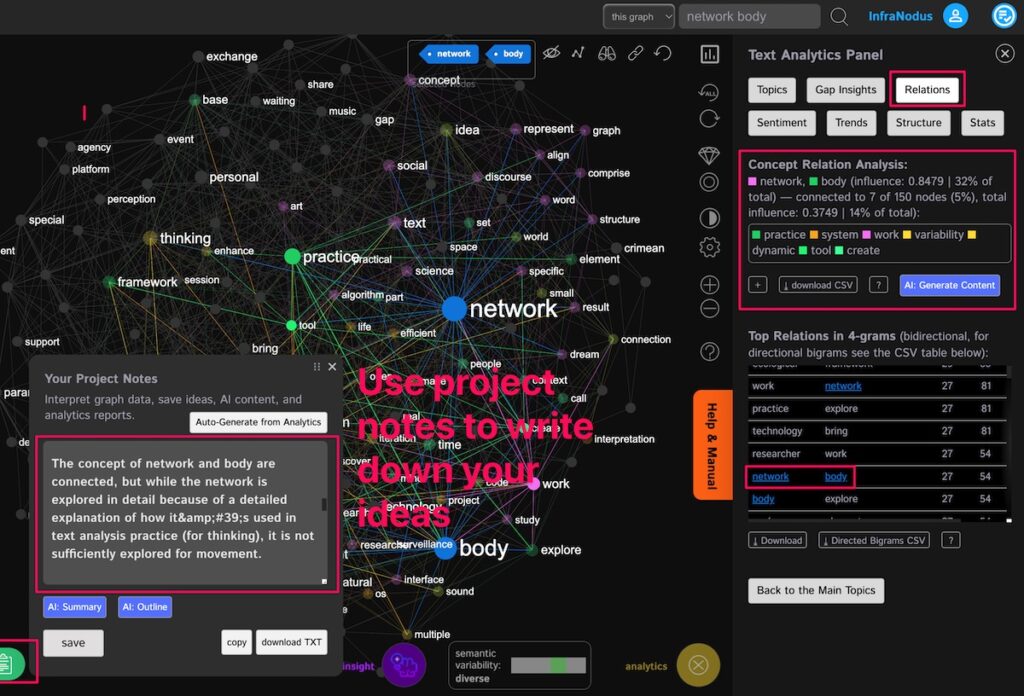
While I think that conceptually it’s pretty interesting, I still feel that this way of thinking about it is a bit dry: I talk about body from a mathematical perspective, which is my approach, but I would still expect a bit more affect in my thinking and writing. So this is another feedback that I can use for myself to help me develop a part of myself, psychologically, that I would expect to be better represented.
Use the Project Notes on the left-hand side to write down your insights and discoveries about yourself. This will be useful later for generating ideas using the AI.
General workflow outline for this step:
- Think of what you expected to see on this graph
- See if what you expected is prominent on the graph (big, central, containing a high number of nodes, a certain relation)
- If you find any discrepancy (e.g. expected something to be an important topic and it isn’t — perhaps, it’s an indication that it could be developed further)
- Use the project notes field to write down your observations and ideas
Using Personal Data Visualization as a Mirror
Now that we had an overview of our ideas and detected some discrepancies between our expectations and reality, it’s time to use all these insights to see how we can develop our ideas further. As this analysis is performed on the text that we’re writing about ourselves, we expect those ideas to be highly relevant to our personal development.
It is important to notice that when we talk about personal development, we’re not in the business of self-optimization and being a “better version” of ourselves. Both of those concepts imply that something is not good enough or wrong and this is not a good place to start. Rather, our approach is based on detecting discrepancies (as in the last step) and gaps in our thinking in order to discover the new connections that we can make between our ideas as well as the topics that we want to develop further. The objective here is to explore oneself and to go deeper into one’s interests, especially those that seem important and, at the same time, underrepresented.
We already started this process in the previous step when we were detecting the gaps between our expectations and the visualization we got. In that way, data visualization is a great tool for introspection because it can be used like a mirror: we project a representation of ourselves outside in order to be able to see it from another perspective:
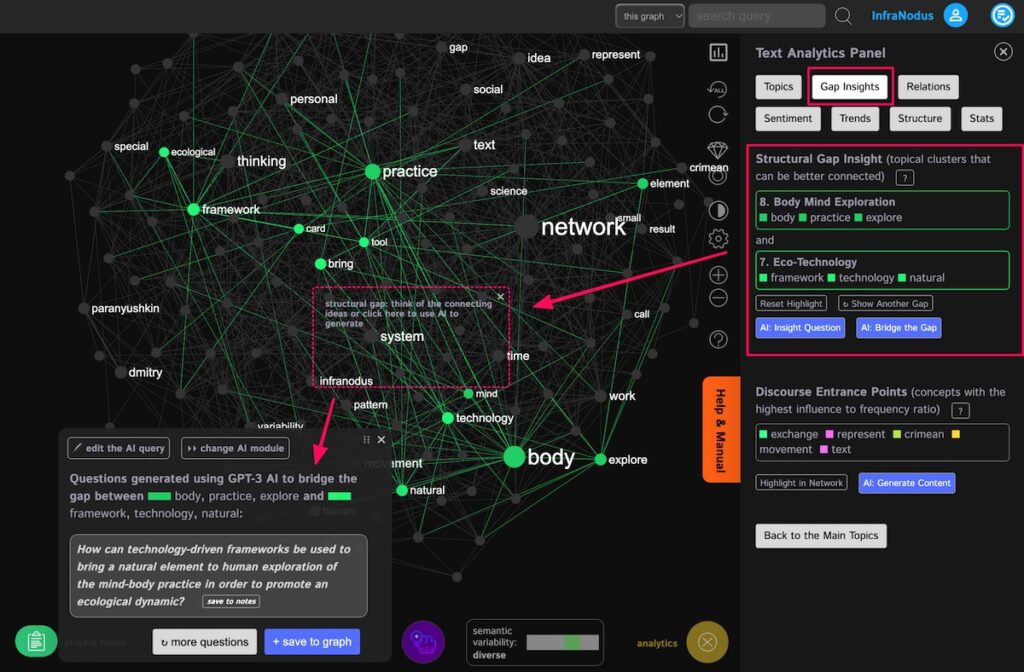
For instance, in the image above we use the Analytics > Insight Gap feature of InfraNodus which detects a structural gap in our thinking and then uses GPT-3 AI to generate a question that would bridge this gap and connect our existing ideas in a way that we haven’t done before. In this case, it’s proposing me to think how the technological frameworks that I use in my work can be used to promote exploration of natural element and ecological dynamics in bodymind practice — a topic I would definitely like to develop further in my future work.
This is one of the bases of any psychological work and network thinking combined with AI can be very useful in this regard. Just like a therapist who helps a patient to bring their ideas to the surface of the conscious mind, InfraNodus helps you to get an overview of all the connections and discrepancies. Then, it will use the AI, an impartial outside observer, to simply help you think in a direction where your discourse about yourself can become more connected and coherent.
…
This is the first part of the article. We will be posting the second part in a few days and you can subscribe to our newsletter to be informed when this article is online.
If you would like to try out the above approach on your own diary or ideas, please, sign up for a free account on www.infranodus.com

